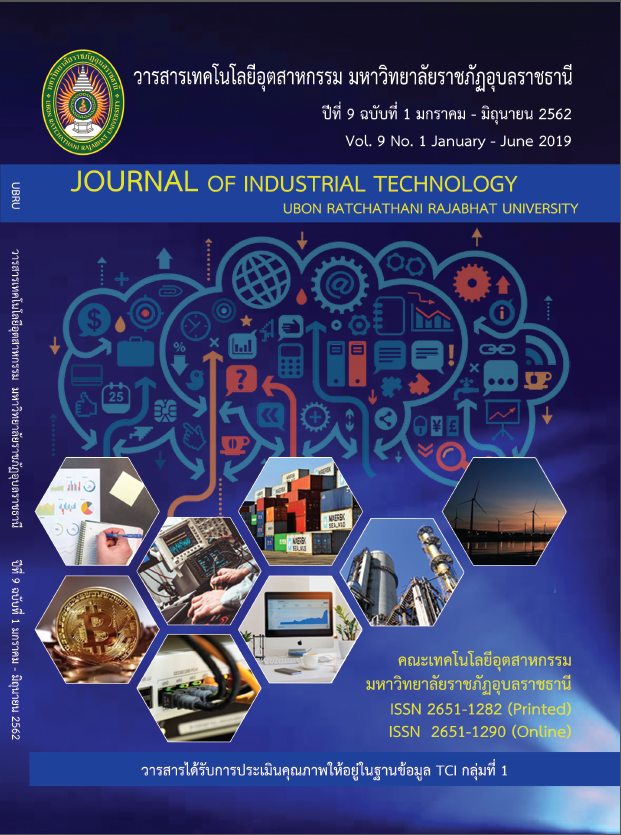Development of Porous Continuous Openings in Clay-Body for Preparation of Ceramic Water Filters with the Addition of Agricultural Materials
Main Article Content
Abstract
The purpose of this research was considered about the physical characteristic of clay body for ceramic equipment preparation of the water filter for drinking by adding up with agricultural residues in order to open the pores at a temperature of 750°C and 800°C, for continuous comparison of the pore opening, and water quality by filtering in preparing the clay body for ceramic water filter. Using local clay body, including waste, sawdust, coconut husks and black husks are mixtures of clay body. Resolution of the local clay and waste ground was composed within an average of 35 meshes by using the maximum temperature 750°C and 800°C. The texture ratio of 15 formulas ratio was controlled by 70 % of local clay, waste ground, sawdust, and coconut coir, including 30 % of black rice husk. The research outcome of the property does not meet the criteria set at 750°C, qualifying for 800°C at combustion ratio of 11 and 12 meets the selection criteria. The strength is more than 2.5 Mpa, the shrinkage within 6%, porosity in the range of 27%, and water absorption within 19% respectively. The water quality test by using filtration through soil formula 11 of three major sources: surface water, piped water, and water from the Huai Mong showed turbidity before filtration 2 2 4 FAU respectively; after the filter has turbidity 1 2 2 FAU respectively. No coli form bacteria is found and the fecal coli form bacteria, both before and after the filter. The mixture ratio of 11, also 12 can be used in developing further research process
Article Details

This work is licensed under a Creative Commons Attribution-NonCommercial-NoDerivatives 4.0 International License.
Articles published in Journal of Industrial Technology Ubon Ratchathani Rajabhat University both hard copy and electronically are belonged to the Journal.
References
[2] Youmoue M, Fongang RTT, Sofack JC, Kamseu E, Melo UC, Tonle IK, et al. Design of ceramic filters using Clay/Sawdust composites: Effect of pore network on the hydraulic permeability. Ceramics International. 2017; 43: 4496-507.
[3] Zhu L, Dong Y, Hampshire S, Cemeaux S, Winnubst L. Waste-to-resource preparation of a porous ceramic membrane support featuring elongated mullite whiskers with enhanced porosity and permeance. Journal of the European Ceramic Society. 2015; 35: 711-21.
[4] Waitayawongsakul S. Porous ceramic. 2016 [cite 2016 March 14]. available from: https://www.material.chula.ac.th/RADIO45/September/radio9-2.htm (in Thai)
[5] Rakthaijareancheep S. Porous ceramic. 2016 [cite 2016 March 14]. available from: https://ceramic. dss.go.th/files/pdf/porous_ceramic.pdf (in Thai)
[6] Gertprathum S. Water purifier. 2018 [cite 2018 January 9]. available from: https://www.tistr.
or.th/ed/?p=496 (in Thai)
[7] Jindawuttikul S. Measurement of specific surface area and porous volume of absorbent material. Department of science service. 2012; 60(189): 22-24. (in Thai)
[8] Hagan JM, Harley N, Hughes R, Chouhan A, Pointing D, Sampson M, et al. Resource Development International - Cambodia Ceramic Water Filter Handbook. Version 1.1., Phnom Penh, Cambodia. 2009.
[9] American society for testing materials. ASTM C326-82: Standard test method for drying and firing Shrinkages of ceramic whiteware clays. Pennsylvania: ASTM; 2002.
[10] Malee U. The Research of Clays from Ban Bo Suak in Nan Province. Journal of Industrial Technology Ubon Ratchathani Rajabhat University. 2560; 2: 234-44.
[11] Royal Thai Government Gazette. Thai in industry standards 601-2546 ceramic ware in contact with food: earthenware [Internet]. 2017 [cite 2017 November 1]. available from:
https://www.ratchakitcha.soc.go.th/DATA/PDF/00127228.PDF (In Thai)
[12] Ryan, W. and Radford, C. Whitewares : Production, testing and qality control. 2nd Edn., London: The Institute of Materials; 1997.
[13] Ingsiriwat P. Ceramic body. Bangkok : Odeonstore; 1998. (In Thai)
[14] Tanthunwet M. Handbook of water analysis. 4th ed. Bangkok: Chulalongkorn University; 2003. (in Thai)
[15] Suan Sunandha Rajabhat University. Shrinkage [Internet]. 2017 [cite 2017 November 2]. available from: https://www.teacher.ssru.ac.th/reudee_ni/file.php/1/Book-CeramicTest/physic-chapter6.html (in Thai)
[16] The Energy Policy and Planning Office. Biomass [Internet]. 2016 [cite 2016 March 14]. available from: https://www.eppo.go.th/engy/Load/ET08.pdf (in Thai)
[17] The Ministry of Natural Resources and Environment Announcement. Standard ground water to use edible, Ratchakitcha: 125(85) 2016 [cite 2016 March 14]. available from: https://lab.dgr.go.th/images/std.pdf (in Thai)
[18] Forest industry Organization. The standard industrial products for water consumption according TIS257-2006 2016 [cite 2016 March 14]. available from: https://www.fio.co.th/p/ tisi_fio/fulltext/TIS257-2549.pdf (in Thai)

